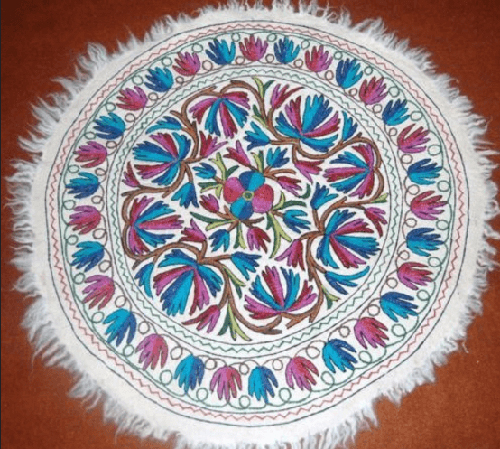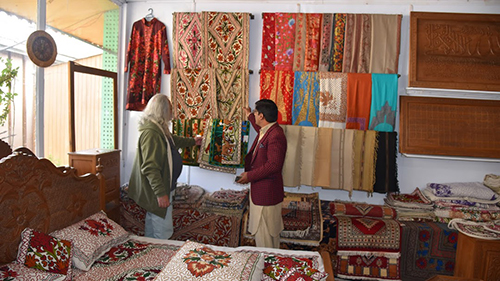Written by: Sadaf Shahzad
Posted on: July 02, 2020 |  | 中文
| 中文
The Red Fort Overlooking the Neelum River and City of Muzaffarabad
The town of Muzaffarabad is the capital of the beautiful and naturally abundant region of Azad Jammu and Kashmir. Muzaffarabad is the meeting point of the rivers Jhelum and Neelum, and offers breathtaking views of the Tarai Mountains, which are at the foothills of the Himalayas. The town is named after the ruler of the Bomba Dynasty, Sultan Muzaffar Khan, who first established a town in the region.
While Kashmiri is the native language of the area, almost everyone speaks Urdu. But one can also encounter local languages like Shina, Mirpuri, Balti Potohari and Pahari.
It is not just the district of Muzaffarabad, but the region of Kashmir that is famous for its natural resources. The forest covers about 60% of the fertile land, and the region is famous for its Deodar, Fir, Walnut, Blue Pine forests among others. There are also terraces for wheat, rice, maize and vegetable cultivation, and precious stones like aquamarine, ruby and garnet can be found in the mineral reserves.
The town is about a 4-hour drive from Islamabad, through Murree or Abbottabad. There is also a bus that travels 127km fortnightly from Muzaffarabad to Srinagar in Indian Occupied Kashmir (IOK), but this route is heavily guarded on both sides of the Line of Control, which divides India from Pakistan. The bus service was temporarily shut down in 2019 after the Pulama Attack, and the service has not been revived since.
Unfortunately, the city is still trying to move on from the earthquake of 2005. Much of the tourist industry has been affected as historic sites have collapsed, and there are not enough resources within the district to counter future tremors. The threat of natural disaster, plus the political tensions between the two neighboring countries have prevented people from investing in the tourist industry.
However, this does a great disservice to the wealth of opportunities and wonderful sites to discover in Muzaffarabad. The town, its history and the warmth of the people are enough to keep tourists returning to it.
One of the highlights of this humble town is the Red Fort, a crumbling fort which has seen many empires come and go. The fort is a mere 15 minutes from the town, along the banks of the Neelum River. It was originally built in the Chak Dynasty in 1559, when Muzaffarabad was still called Chakrs Bahak. The Mughals under Akbar annexed the land in 1587, but the site was reclaimed by Muzaffar Khan in 1646, who repaired and completed the fort.
It was in 1846 that the Fort came under Maharaja Gulab Singh and his successor Maharaja Ranbeer Singh, who established the Dogra Dynasty in the kingdom of Jammu and Kashmir. They used the fort till the establishment of a cantonment in Muzaffarabad in 1926, after which the Fort was no longer operational.
Some other interesting sites around the area are for those who enjoy adventure and nature. The shrine of Pir Chinasi is located a few minutes away from Muzaffarabad, and stands at an altitude of 2,900 meters. It can be reached via a jeep or a walking trek, traversing a long, winding road up the mountain.
The shrine is very different in architecture from the more popular shrines in Pakistan; the turquoise tomb has a disc-shaped roof, which forms a trapezoid shape on top of the structure. The sound of worshipers and the quiet scenic beauty makes this place unforgettable in its serenity.
Similarly, the picturesque Shaheed Gali is a mere 16km away from the town center, and is located opposite Pir Chinasi. The Sri Kot point on the route is a spot surrounded by lush forests and a cool breeze greets the visitor. Standing there, one truly understands the seemingly unending beauty that Kashmir has been famous for.
For those who want a more relaxed destination, a small dhaba (roadside café) is located next to the beautiful Kashmir Waterfall Dulai. Visitors come to dip their toes in the cool water, while drinking piping hot tea and eating pakoras on a lazy afternoon.
The largest market in the city is Madina Market, where tourists can find local handicrafts and foods. There are colorful and heavy-detailed embroidery on shawls, warm phairan (kaftans) which women wear in the winters, and hand-made carpets from the local industry. Muzaffarabad is also known to have the best apples, walnuts, plums and apricots to bring back home.
It is said that Kashmiris are very fond of their food, and are proud of their traditions of hospitality. To battle the long winters, their food is often high in fats, much like the cuisine of Gilgit-Baltistan. Dinners with guests are often long and drawn out, with large portions and lively discussions. But it is a custom to end meals on a sweet note, with deserts like firni (rice pudding), sviyaan (angel hair pasta dessert). The famous salty Kashmiri chai and the thick Bakarkhani bread is a popular breakfast combination with the locals.
The city of Muzaffarabad carries a lot of potential as a thriving tourist destination. The land is breathtaking, and elements of its diverse, often poignant history remain etched in people’s hearts long after they leave. More investment and more facilities are needed to promote a potentially booming tourist industry, which will benefit and provide employment to the local population.



You may also like: